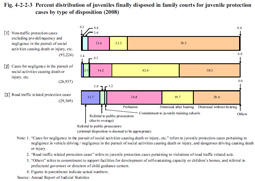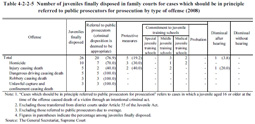| Previous Next Index Image Index Year Selection | |
|
|
2 Family courts (1) Received casesFig. 4-2-2-2 shows the number of juveniles newly received by family courts for juvenile protection cases since 1949. The number of juveniles received for non-traffic protection cases (refers to juvenile protection cases excluding the road traffic related protection cases defined below; hereinafter the same in this subsection) reached a peak in 1966 and again in 1983, and then continued to decrease for a number of years. In recent years it has remained at around 200,000 but then decreased every year from 2004 to 2008. The number of juveniles received for road traffic related protection cases (refers to juvenile protection cases pertaining to violations of road traffic related acts; hereinafter the same in this subsection) decreased sharply after the traffic infraction notification system was applied to juveniles in 1970 and its scope of application expanded in 1987. The number has subsequently been on a decreasing trend, even in recent years. Fig. 4-2-2-2 Number of juveniles newly received by family courts for juvenile protection cases (1949–2008) (2) Dispositiona. Overview of final disposition Fig. 4-2-2-3 shows the percent distribution of juveniles finally disposed in family courts for [1] non-traffic protection cases (excluding pre-delinquency and negligence in the pursuit of social activities causing death or injury, etc. cases of [2]), [2] negligence in the pursuit of social activities causing death or injury, etc. cases (refers to juvenile protection cases concerning negligence in vehicle driving / negligence in the pursuit of social activities causing death or injury and dangerous driving causing death or injury), and [3] road traffic related protection cases by type of disposition in 2008. Fig. 4-2-2-3 Percent distribution of juveniles finally disposed in family courts for juvenile protection cases by type of disposition (2008) Fig. 4-2-2-4 shows the percent distribution of juveniles finally disposed in family courts for homicide and robbery by type of disposition in 2008.See Appendix 4-10 for the number of juveniles finally disposed in juvenile protection cases by type of delinquency and type of disposition. Fig. 4-2-2-4 Percent distribution of juveniles finally disposed in family courts for homicide and robbery by type of disposition (2008) b. Disposition of cases referred to public prosecutors for prosecutionA case where a juvenile aged 16 or older caused death of a victim through an intentional criminal act is, in principle, required to be referred to public prosecutors for prosecution. Table 4-2-2-5 shows the number of juveniles finally disposed in family courts for such cases (excluding cases where juveniles were referred to public prosecutors due to being overage; hereinafter the same in this subsection) by type of offense in 2008. During the period from April 1, 2001 through to the end of 2008, a total of 448 juveniles committed such offenses and 283 (63.2%) were referred to public prosecutors for prosecution (Source: The General Secretariat, Supreme Court). Table 4-2-2-5 Number of juveniles finally disposed in family courts for cases which should be in principle referred to public prosecutors for prosecution by type of offense (2008) |



